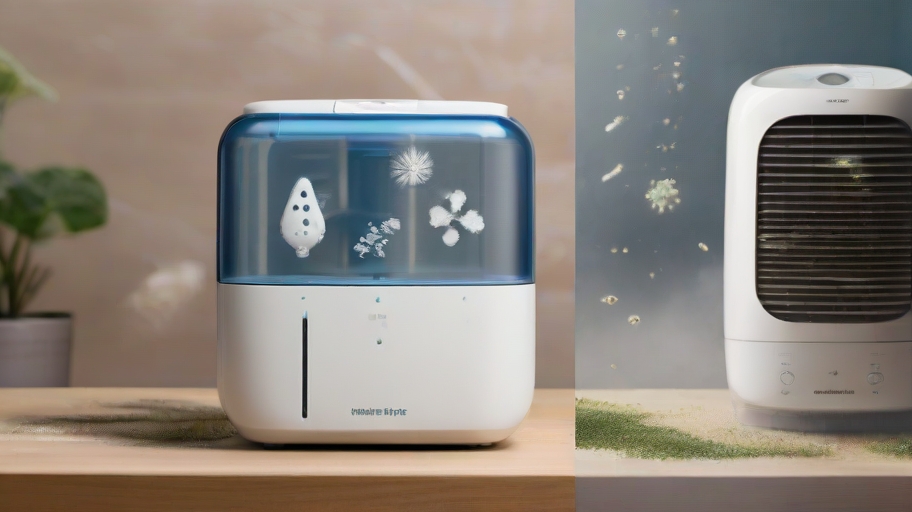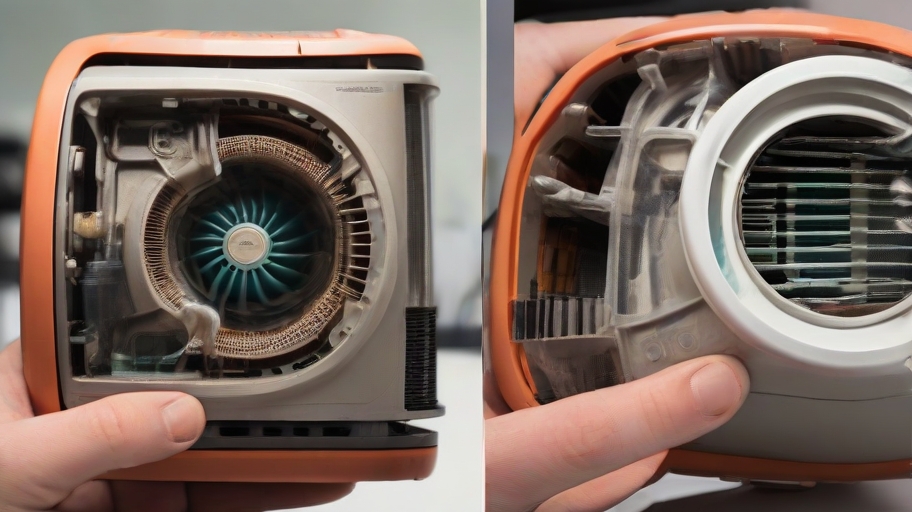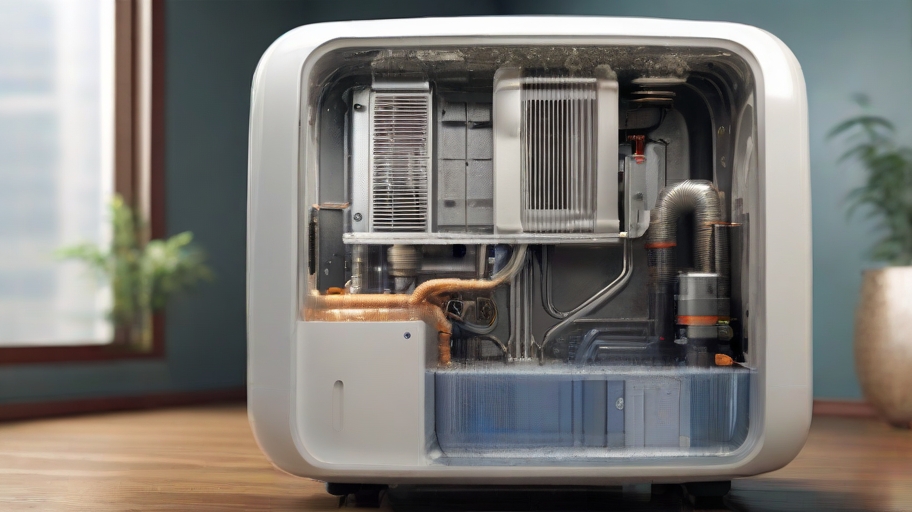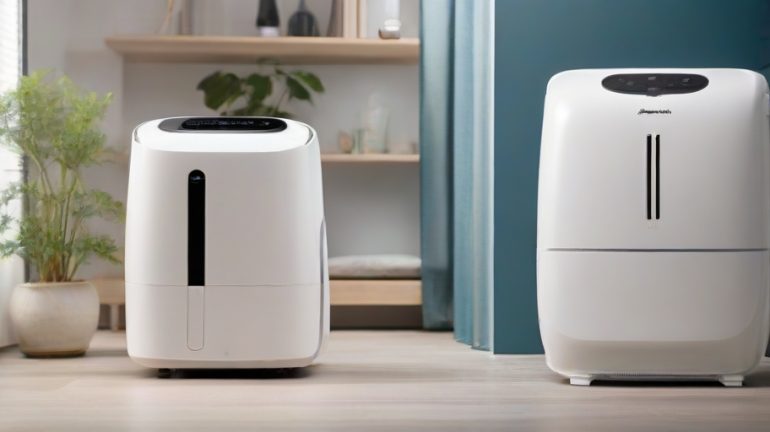As you stand at the crossroads of indoor air quality, with a dehumidifier on one path and an air purifier on the other, your choice could define the atmosphere of your home. Therefore, remember this isn’t just about buying a device. This choice has the potential to make your home healthier and more pleasant.
If you struggle with high humidity, a dehumidifier might be the most significant piece in cutting through the moisture that can harbour moulds and allergens.
On the other hand, if invisible particles like dust, pollen, or smoke are your main competitors, an air purifier could serve as your filter-wielding champion, ready to cleanse your air of these unwanted invaders.
Air Purifier VS Dehumidifier: Which One Succeeds in Indoor Air Quality?

Here are the significant distinctions to consider when comparing dehumidifiers and air purifiers:
Dehumidifiers:
- Control the humidity levels within a room or an area
- Draw out excess moisture in the air
- Aid in inhibiting the development of mould and mildew
- Improve the quality of air by decreasing the number of allergens and similar particles that flourish in humid conditions
- Tend to make noise and necessitate regular upkeep like emptying water reservoirs and cleaning filters
- It may lack efficacy in voiding certain kinds of air pollution, such as smoke and unpleasant smells
Air Purifiers:
- Extract pollutants and impurities from the atmosphere
- Improve indoor air quality
- Alleviate allergy and asthma symptoms by removing common allergens present in the air
- Could incorporate various technologies to filter out particles and pollutants, including HEPA filters, UV-C light, and activated carbon filters
- Are usually silent and low-maintenance, with some models boasting automatic sensors and timing mechanisms
- Might lack the capacity to manage the humidity levels within a room or area
How Do Air Purifiers Work?

How do air purifiers do their magic? Well, it’s simpler than you might think. These handy devices suck in the air from your room and pass it through specialised filters. The notable here is usually something called a HEPA filter – this little wonder can grab hold of tiny particles like dust, pollen, and even bacteria.
Some air purifiers are equipped with an activated carbon filter too, which helps to wave goodbye to stinky smells. Certain models even use UV lights to zap germs dead in their tracks. After going through this clean-up operation, the air purifier sends that clean, fresh air right back out into your room. It’s like a non-stop spa day for your home’s air, keeping it crisp and clean around the clock.
Dehumidifier: How They Dry Your Space

While air purifiers focus on removing airborne contaminants, dehumidifiers tackle excess moisture by drawing in humid air and extracting the water before recirculating drier air back into the room.
As you rely on a dehumidifier to create a more comfortable living environment, understand the technical aspects of how they remove moisture from the air:
- Humidity Extraction: Dehumidifiers help by pulling in moist air, passing it over a refrigerated coil to condense the moisture, and then collecting it in a tank.
- Air Recirculation: After removing excess moisture, the unit expels the drier air back into the space, reducing the overall humidity level.
- Mould Prevention: By reducing moisture, dehumidifiers create conditions less favourable for mould and allergen proliferation.
- Comfort Enhancement: A dehumidifier’s ability to process and dry out moist air helps maintain a stable and comfortable indoor climate.
Pros and Cons of Air Purifiers and Dehumidifiers
Understanding the advantages and drawbacks of an air purifier and a dehumidifier is crucial for optimising indoor air purity to suit your specific needs.
Dehumidifiers remove moisture, thereby creating a less hospitable environment for mould, which can help with damp issues and reduce mould proliferation. They’re essential in wet areas and improve the ambient atmosphere by lowering humidity levels. However, they don’t target allergens and irritants such as pollen or pet dander.
Conversely, air purifiers can help eliminate these airborne particles, providing relief for allergy and asthma sufferers. They’re particularly adept at purifying the air from various pollutants but don’t affect humidity levels.
While both serve different purposes, using them in tandem addresses a broader range of clean air index issues. Remember to consider room size, energy efficiency, and maintenance when deciding between them.
Key Considerations When We Choose Between a Dehumidifier or Air Purifier
Choosing the right device for your home involves considering various factors, each with its own advantages and limitations. To ensure that your decision effectively sweetens the overall indoor air quality, take note of the following:
- Addressing Specific Air Quality Concerns: If you’re dealing with excessive humidity that promotes mould growth, a dehumidifier would be a suitable choice. On the other hand, if you’re looking to eliminate allergens or combat outdoor pollution, air purifiers are specifically designed for these purposes.
- Considering Room Size: It’s important to select a device that’s appropriate for the size of the room. A small air purifier wouldn’t effectively clean a large space.
- Taking Health Conditions into Account: For individuals with asthma or allergies, maintaining air quality is necessary. In such cases, an air purifier equipped with a HEPA filter can provide additional benefits.
- Noise Level: Dehumidifiers are generally noisier compared to air purifiers, so it’s important to ponder on the level of sound if you aim to utilise the device in a sleeping area or another serene setting.
- Energy Efficiency: Opt for versions that are renowned for energy conservation and exert minimal strain on your electricity bills.
- Servicing Demands: Evaluate the upkeep requisites of each appliance, featuring elements such as the need for filter exchanges, draining the water receptacle, and routine cleansing.
- Cost of Running: Gauge the price tags of varying models and brands, along with the continuous expenses related to maintenance and usage.
Frequently Asked Questions
How effective is a dehumidifier in removing allergens from the air?
Whilst a dehumidifier removes excess moisture and can help relieve damp conditions that encourage the growth of mould and dust mites, it does not effectively remove allergen particles from the air. If you need to clear the air of allergens, an air purifier is a better option.
Can a purifier and dehumidifier run together?
Yes! Cleverly integrating both devices could help create an even more comfortable indoor environment. The dehumidifier absorbs excess moisture from the air which helps to prevent mould and dampness. In contrast, air purifiers are designed to remove contaminants from the air, dust, and other allergens.
Can an air purifier help reduce the workload on my air conditioning system?
By improving the overall air quality, an air purifier indirectly reduces the burden on your air conditioning system. Cleaner air tends to circulate faster and more efficiently. However, air purifiers aren’t alternatives or direct helpers to air-conditioning systems.
How do I choose between a dehumidifier and an air purifier?
Your choice should be based on the specific needs of your indoor environment. If there’s excess humidity or signs of mould, a dehumidifier might be the better choice. However, if you’re struggling with allergies due to dust, pet dander, or pollen, an air purifier may be more helpful.
What happens if I don’t use a dehumidifier or an air purifier?
If your home suffers from high moisture levels or poor atmospheric conditions, failing to address these issues can lead to health problems over time. Excessive moisture can promote the growth of mould and mildew, which can trigger allergies and exacerbate respiratory conditions. Poor quality of the atmosphere can also contribute to a range of health issues, including allergies, asthma, and other respiratory problems.

